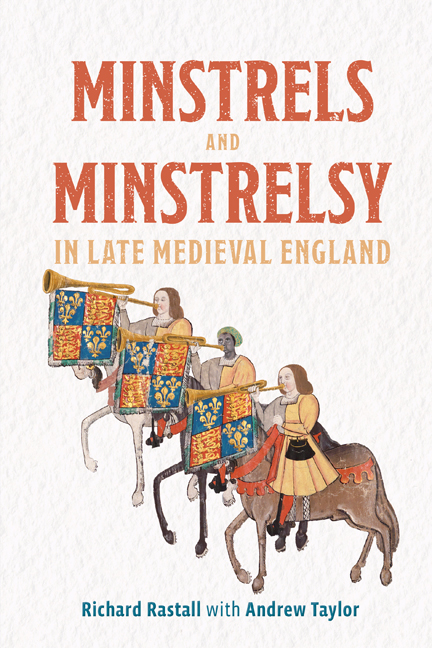Book contents
- Frontmatter
- Dedication
- Contents
- List of illustrations
- List of music examples
- List of abbreviations
- A note on references
- A note on money
- A note on dates
- Preface
- Acknowledgments
- Part I Minstrels and Minstrelsy in the Elite Households
- Part II Urban Minstrelsy
- Part III On the Road
- Part IV Minstrel Performance
- Envoi
- Bibliography
- Index
6 - Minstrelsy in the towns
Published online by Cambridge University Press: 09 January 2024
- Frontmatter
- Dedication
- Contents
- List of illustrations
- List of music examples
- List of abbreviations
- A note on references
- A note on money
- A note on dates
- Preface
- Acknowledgments
- Part I Minstrels and Minstrelsy in the Elite Households
- Part II Urban Minstrelsy
- Part III On the Road
- Part IV Minstrel Performance
- Envoi
- Bibliography
- Index
Summary
The towns of late medieval England
To modern minds, medieval towns were surprisingly small. Most of them held fewer than 1,500 people, and at the lower end of the scale there was little to distinguish towns from the larger villages. Those that grew prosperous through trade, especially through the textile trade with continental outlets, formed a select group of towns with populations of perhaps 5–10,000. At a high point in 1348 London may have numbered as many as 80,000 people, most of whom lived within the city walls, but the Black Death of 1348–9 was devastating. The plague revisited London and other cities several times in the 1360s and early 1370s, and the Poll Tax of 1377 assessed just over 23,000 people in London. It is estimated that the total population of London, Southwark and Westminster at this time could hardly have been more than 45–50,000. Although the population increased through the fifteenth century, London did not return to its former size until the sixteenth.
York, the country's second city, was created a county corporate in 1386. It probably had a population of around 15,000 by 1348, reduced to 50–70% by 1350. Bristol, widely regarded as the third city of the country and created a separate county in 1373, was rather smaller than York; and Norwich, also claiming to be third only to London and York for much of the Middle Ages, had a population that ‘may have reached 20,000’, much reduced by the Black Death and estimated at 6,600 from the Poll Tax returns of 1377. Coventry, which ‘recovered quickly from the Black Death (1348–50) and remained prosperous for roughly a century thereafter’, paid ‘the fourth-highest poll-tax in the kingdom’ in 1377. These very prosperous trading towns were highly influential in the fourteenth and fifteenth centuries, with far more power than the old county towns such as Exeter (with a population of around 3,000 after the Black Death), Lincoln (between 5,000 and 10,000 before the Black Death, fewer than 4,000 in 1377), Nottingham and Leicester.
- Type
- Chapter
- Information
- Minstrels and Minstrelsy in Late Medieval England , pp. 129 - 145Publisher: Boydell & BrewerPrint publication year: 2023



